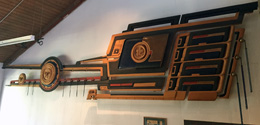On February 27, 2004, Sin-Aikst (Colville) Indian artist Lawney Reyes (b. 1931) attends a dedication ceremony at the Daybreak Star Indian Cultural Center for a sculpture he created called Blue Jay, which honors his brother, Native American activist Bernie Whitebear (1937-2000). Reyes created the sculpture in 1972, when the Bank of California commissioned him to make a piece for its Seattle office. The ceremony, which features drumming, singing, and a prayer for Whitebear, marks the bank's donation of the sculpture, more than 30 years after its creation, to Daybreak Star. The cultural center, located in Discovery Park in Seattle's Magnolia neighborhood, was headed by Whitebear from its opening in 1977 until his death.
An Honoring -- and "a Joke" -- Sculpted in Pine
Lawney Reyes, his brother Bernard (who would later take the name Whitebear), and their sister Luana Reyes (1933-2001) grew up in poverty largely on the Colville Indian Reservation in Eastern Washington. All three went on to prominent careers, Lawney as an artist, designer, architect, and eventually author; Bernie as a leading activist in the "Red Power" movement of the 1970s and beyond; and Luana with local and national Indian health agencies.
Blue Jay was a 30-foot-long sculpture that Lawney Reyes crafted from white sugar-pine, with copper inlays, leather, and beaded fringe. Parts of the sculpture were stained mahogany, crimson, and ultramarine. The piece combines styles from the Salish and Pacific Northwest Native traditions. The bird's scissor beak holds a nut carved to resemble the sun.
When it came time to design the eye, Reyes struggled to find an appropriate image. He later recalled, "Bernie watched me carve it out ... I was trying to figure out what to put in the eye" (Dillon). Eventually, Reyes carved a bear holding a white man -- a clear reference to Whitebear's sometimes difficult interactions with white people during his efforts to empower Native Americans. Reyes said, "It was meant, more or less, as a joke between my brother and I ... But it fit in the design and I wanted the piece to remember my brother" (Long).
A Belated Homecoming
The return of Blue Jay to Daybreak Star marked a fitting reunion.
On March 8, 1970, Whitebear was a leader in an occupation of Fort Lawton, a facility in Seattle's Magnolia neighborhood that the U.S. Army planned to decommission. Undertaken by the United Indian People's Council (later United Indians of All Tribes Foundation a.k.a. UIATF), the nonviolent occupation was a response to failed discussions with local officials to acquire some of the soon-to-be decommissioned land. Hundreds of Native Americans and their supporters joined Whitebear and other leaders, including Puyallup Tribe activist Bob Satiacum (1929-1991). Some protesters were hauled to jail.
After months of negotiations and federal intervention, the occupation proved successful. The city offered UIATF a 99-year lease for 20 acres of land, and Whitebear asked Reyes to help design a structure. Working with architects Clifford Jackson and Yoshio Arai, Reyes designed Daybreak Star Indian Cultural Center. The center opened on May 13, 1977, Reyes' forty-sixth birthday (Reyes, 99-112). Whitebear served as UIATF executive director, and he maintained an office in Daybreak Star until the time of his death.
"Where He Belongs"
At the time Blue Jay was commissioned, Reyes worked as interior designer for Seattle First National Bank (Seafirst). In creating the work for Bank of California, he designed a piece for a competitor. Whitebear would take friends to see the sculpture, telling them that he had created it. During the dedication ceremony Reyes said, "People have been coming up to me saying, 'I thought Bernie did it'" (Dillon).
Bank of California housed the piece in its office downtown. But in what was deemed a "significant" return (Long), the bank (then known as Union Bank of California) donated Blue Jay, along with a buffalo-hide painting and an oil painting, to Daybreak Star in December 2003. The sculpture was dedicated in its new home with a ceremony held on February 27, 2004. UIATF arts coordinator Marlee Markishtum said, "Lawney is so tied to this place, not just because he was one of the architects for the center, but his family has strong ties here. It's interesting to note, Bernie is right back here where he belongs" (Long).

